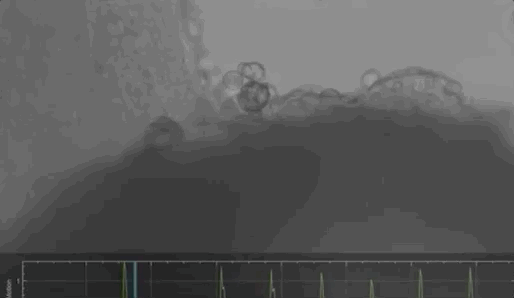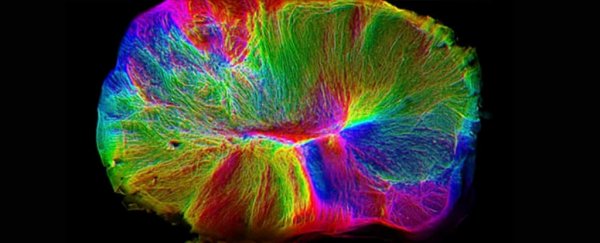Lab-growing the most complex structure in the known Universe may sound like an impossible task, but that hasn't stopped scientists from trying.
After years of work, researchers in the UK have now cultivated one of the most sophisticated miniature brains-in-a-dish yet, and it actually managed to behave in a slightly freaky fashion.
The grey blob was composed of about two million organised neurons, which is similar to the human foetal brain at 12 to 13 weeks. At this stage, this so-called 'brain organoid' is not complex enough to have any thoughts, feelings, or consciousness - but that doesn't make it entirely inert.
When placed next to a piece of mouse spinal cord and a piece of mouse muscle tissue, this disembodied, pea-sized blob of human brain cells sent out long, probing tendrils to check out its new neighbours.
Using long-term live microscopy, researchers were able to watch as the mini-brain spontaneously connected itself to the nearby spinal cord and muscle tissue.
"We like to think of them as mini-brains on the move," neuroscientist Madeline Lancaster from the Medical Research Council Laboratory of Molecular Biology told The Guardian.
Moving isn't their only skill. These mini-brains were also the first samples to initiate muscle movement, just as motor neurons do in our own brains.
Under their mini-brain's control, the researchers noticed visible and controlled muscle contractions. What's more, by briefly stimulating one of the axon tracts, the team could elicit a robust and organised muscle contraction of their own.
"After 2-3 weeks in co-culture, dense axon tracts from the [organoid] could be seen innervating the mouse spinal cord and synapses were visible between human projecting axons and neurons of the mouse spinal cord," the authors write.
"Live imaging of the mouse muscle tissue revealed sporadic concerted muscle contractions with an irregular periodicity."
 (Medical Research Council)
(Medical Research Council)
Brain organoids are some of our best tools for understanding human brain development and disease, but cultivating them beyond a certain stage is challenging.
Today, most brain organoids are grown from human stem cells, which spontaneously organise themselves into the structures and layers needed for early brain development.
The problem is, once this cluster gets to a certain size, the middle becomes deprived of nutrients and oxygen and it stops becoming useful.
The present research is one of the first to overcome this limit. By slicing up the organoids and placing them on a porous membrane, the researchers made sure that their mini-brains could simultaneously use the air above and absorb the nutrients below, staying healthy after a year in their dishes.
Yet even though these mini-brain's are more sophisticated than ever before, they are still extremely small, and are far from the full complexity of their natural human counterparts.
Nevertheless, the authors are hopeful that the success of their new approach will allow us to model brain diseases in greater detail than ever before.
"For instance," the authors write, "it opens the door to the study of neurodevelopmental conditions of the corpus callosum, neuronal circuit imbalances seen in epilepsy, and other defects where connectivity is thought to play a role, such as in autism and schizophrenia."
This study has been published in Nature Neuroscience.
